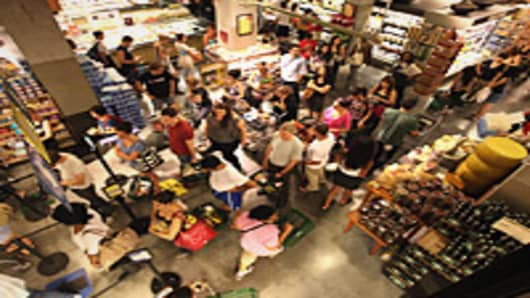Further increase in gasoline prices may force Americans to cut spending, and in turn may hurt consumer-related stocks, says a new report from Barclays Capital .
According to the report, auto parts companies and consumer discretionary names are especially vulnerable to sharp pump price increases.
The stocks that stand out within the Barclays’ coverage universe are: Autozone, OReilly Automotive, Advance Auto Parts, as well as Best Buy , Barnes & Noble , hhgregg , Pier 1 Imports , RadioShack and Williams Sonoma .
“Higher spending on gas due to elevated gas prices may lead to decreased consumption of gas, decreased consumption of other goods, particularly more discretionary products, or lower levels of total consumption,” says the report.
Barclays analysts see downside to their 2012 earnings-per-share estimates for Autozone , OReilly Automotive and Advance Auto Parts if gas prices reach $4.25 or higher. At $4.50 a gallon, the downside risk is 3-4 percent; and at $5 a gallon, the downside risk is 6-9 percent.
The report also notes that “[auto parts] sales respond quickly and negatively to gas price increases but do not experience a corresponding lift with substantial declines in gas prices.”
Advance Auto Parts appears to have the most downside potential, according to the analysts, “given its higher cost structure and the higher distribution costs it could potentially incur.”
But the impact of higher gas prices on consumer spending depends more on the speed and duration of the increase rather than on the level of the increase, according to the report.
“If the rise is gradual and temporary, consumers are better able to modify their savings and spending patterns to smooth out overall consumption. This results in a more modest impact to consumption,” notes the report. “However, if the rise is rapid and sustained, consumers may need to significantly alter the level and composition of their spending levels.”
Barclays analysts see gasoline prices hitting $4.75 a gallon by July, if they rise at approximately the same speed and rate this year as in 2008, when pump prices reached their all-time high.
“Given that gas prices generally rise between now and Memorial Day due to seasonality and differences in refining methods, it appears likely that gas prices could surpass the 2011 peak of $3.99 reached in May 2011 and the historical peak of $4.11 in July 2008,” says the report.
On Monday, the national average price for a gallon of regular hit $3.84, according to AAA, up 30 cents from a month ago. That translates into an extra $6 to fill up a mid-size sedan with a 20-gallon tank. In Alaska, California, Connecticut, District of Columbia, Hawaii, Illinois, New York and Washington pump prices have already crossed the $4 mark.
Tom Kloza of the Oil Price Information Service says gas prices should peak in the next 40 days, between $3.83 and $4.25 a gallon nationally.
According to Kloza, $5-gas would be “an economy-buster”, but it is highly unlikely we will get there, unless there’s a disruption to crude oil supplies in the Persian Gulf.
Last week, Morgan Stanley report warned that stock market could soon lose the resilience it has shown so far if gas prices continue to rise.
Questions? Comments? Email us at marketinsider@cnbc.com and follow me on twitter @kfrayter



